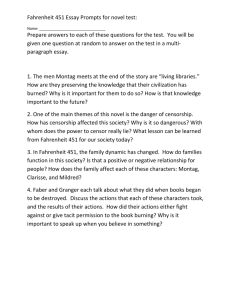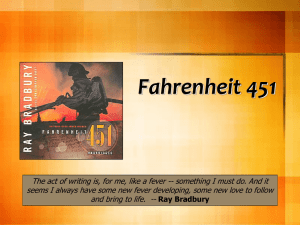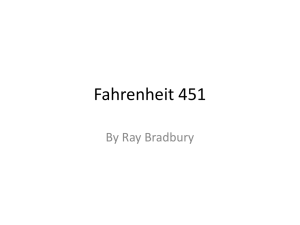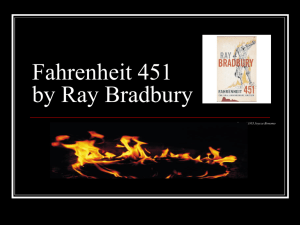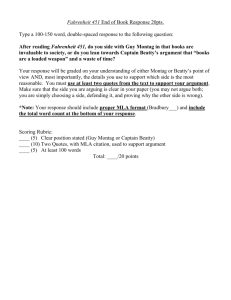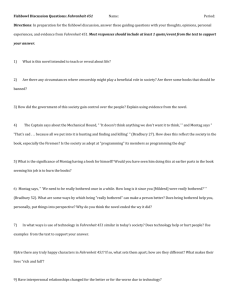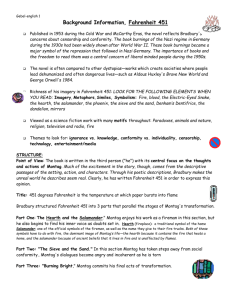Fahrenheit 451 Introduction Sheet
advertisement
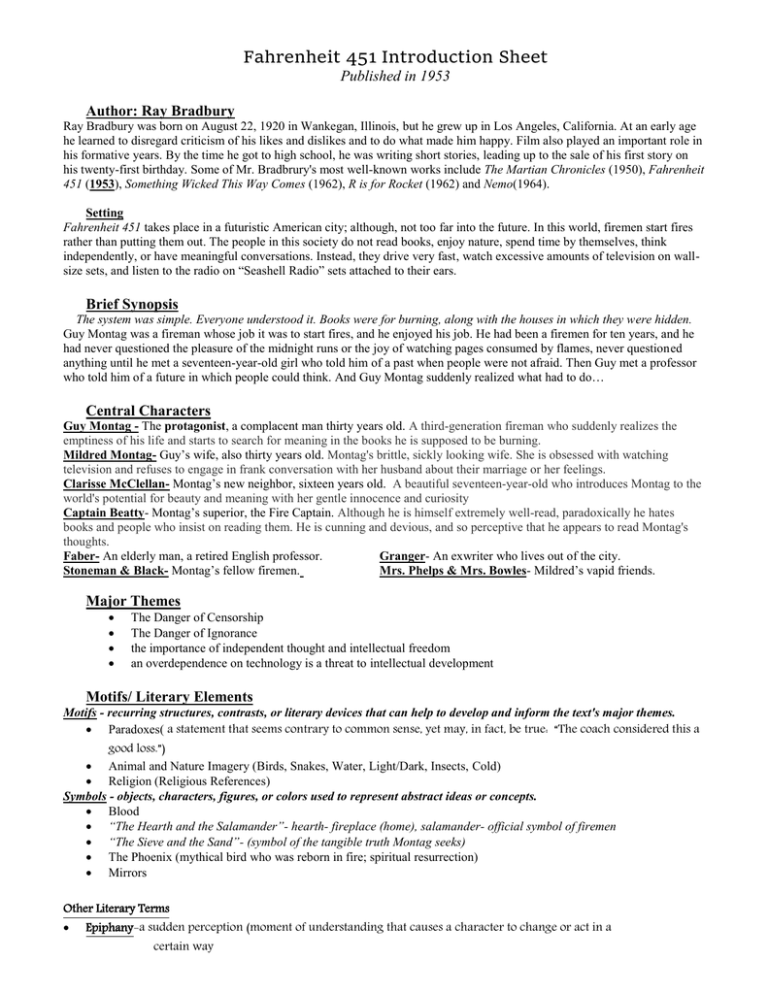
Fahrenheit 451 Introduction Sheet Published in 1953 Author: Ray Bradbury Ray Bradbury was born on August 22, 1920 in Wankegan, Illinois, but he grew up in Los Angeles, California. At an early age he learned to disregard criticism of his likes and dislikes and to do what made him happy. Film also played an important role in his formative years. By the time he got to high school, he was writing short stories, leading up to the sale of his first story on his twenty-first birthday. Some of Mr. Bradbrury's most well-known works include The Martian Chronicles (1950), Fahrenheit 451 (1953), Something Wicked This Way Comes (1962), R is for Rocket (1962) and Nemo(1964). Setting Fahrenheit 451 takes place in a futuristic American city; although, not too far into the future. In this world, firemen start fires rather than putting them out. The people in this society do not read books, enjoy nature, spend time by themselves, think independently, or have meaningful conversations. Instead, they drive very fast, watch excessive amounts of television on wallsize sets, and listen to the radio on “Seashell Radio” sets attached to their ears. Brief Synopsis The system was simple. Everyone understood it. Books were for burning, along with the houses in which they were hidden. Guy Montag was a fireman whose job it was to start fires, and he enjoyed his job. He had been a firemen for ten years, and he had never questioned the pleasure of the midnight runs or the joy of watching pages consumed by flames, never questioned anything until he met a seventeen-year-old girl who told him of a past when people were not afraid. Then Guy met a professor who told him of a future in which people could think. And Guy Montag suddenly realized what had to do… Central Characters Guy Montag - The protagonist, a complacent man thirty years old. A third-generation fireman who suddenly realizes the emptiness of his life and starts to search for meaning in the books he is supposed to be burning. Mildred Montag- Guy’s wife, also thirty years old. Montag's brittle, sickly looking wife. She is obsessed with watching television and refuses to engage in frank conversation with her husband about their marriage or her feelings. Clarisse McClellan- Montag’s new neighbor, sixteen years old. A beautiful seventeen-year-old who introduces Montag to the world's potential for beauty and meaning with her gentle innocence and curiosity Captain Beatty- Montag’s superior, the Fire Captain. Although he is himself extremely well-read, paradoxically he hates books and people who insist on reading them. He is cunning and devious, and so perceptive that he appears to read Montag's thoughts. Faber- An elderly man, a retired English professor. Granger- An exwriter who lives out of the city. Stoneman & Black- Montag’s fellow firemen. Mrs. Phelps & Mrs. Bowles- Mildred’s vapid friends. Major Themes The Danger of Censorship The Danger of Ignorance the importance of independent thought and intellectual freedom an overdependence on technology is a threat to intellectual development Motifs/ Literary Elements Motifs - recurring structures, contrasts, or literary devices that can help to develop and inform the text's major themes. Paradoxes( a statement that seems contrary to common sense, yet may, in fact, be true: “The coach considered this a good loss.”) Animal and Nature Imagery (Birds, Snakes, Water, Light/Dark, Insects, Cold) Religion (Religious References) Symbols - objects, characters, figures, or colors used to represent abstract ideas or concepts. Blood “The Hearth and the Salamander”- hearth- fireplace (home), salamander- official symbol of firemen “The Sieve and the Sand”- (symbol of the tangible truth Montag seeks) The Phoenix (mythical bird who was reborn in fire; spiritual resurrection) Mirrors Other Literary Terms Epiphany-a sudden perception (moment of understanding that causes a character to change or act in a certain way Euphemism- the substitution of an agreeable or inoffensive expression for one that may offend or suggest something unpleasant (instead of saying someone died, one could say someone passed away) Antithesis- an opposition, or contrast of ideas: “it was the best of times, it was the worst of times…” Oxymoron- a combination of contradictory terms as in jumbo shrimp, tough love, or cruel kindness Allusions A comprehensive list of the allusions and their significance will be posted on the website. The following is a list of the significant allusions within Fahrenheit 451. Remember, these references were not made by accident…. Literature and Philosophy Edna St. Vincent Millay, Walt Whitman, William Faulkner, Alexander Smith, Dreamthorp, Dante, Jonathan Swift Gulliver’s Travels, Marcus Aurelius, Helen Bannerman- Little Black Sambo, Harriet Beecher Stowe-Uncle Tom’s Cabin, Samuel Johnson, James Boswell, Sophocles, Aeschylus, Shakespeare- Julius Caesar, Hamlet, Henry David Thoreau - Walden, Luigi Pirandello, George Bernard Shaw, John Milton, Eugene O’Neill, The Chesire Cat, from Lewis Carroll’s Alice in Wonderland, Matthew Arnold- Dover Beach, Sir Philip Sydney, Alexander Pope, Dr. Johnson, Paul Valéry, Thomas Hardy, José Ortega Y Gasset, Plato- The Republic , Arthur Schopenhauer, Aristophanes, Thomas Love Peacock, Lord Byron, Niccolò Machiavelli Historical Figures Benjamin Franklin, Hugh Latimer, Thomas Jefferson, Marcus Aurelius, Einstein, Charles Darwin, Abraham Lincoln, Albert Schweitzer, Confucius, Thomas Paine, Bertrand Russell, The Magna Carta, The Constitution of the United States Religious and Mythological References Hercules and Antaeus, Tower of Babel, The Bible, Old and New Testaments, Job and Ruth, Book of Ecclesiastes, Book of Revelation, Matthew, Mark, Luke, and John, Jesus Christ, Mahatma Gandhi, Gautama Buddha The Dystopian Genre Ray Bradbury’s Fahrenheit 451 is one of the most famous and popular novels ever written belonging to the literary genre known as “dystopias.” This term is derived from “Utopia,” the word that Thomas More used for the title of his sixteenthcentury novel depicting an ideal society; but the earliest work of its type is generally considered to be the 4th-century BC Plato’s Republic, which has in common with the government of Bradbury’s novel a deep suspicion of literature as disturbing and subversive. The first dystopian novel commonly encountered by American readers today is Aldous Huxley’s 1932 Brave New World. It depicts a society in which human beings are treated like different model cars trundling off the Ford assembly line, bred in bottles for designated roles in society comparable to those depicted in Metropolis, as drudges or as self-indulgent but loveless upper-class mindless twits. Societal control is enforced by among other means by the suppression of literary classics. By far the best-known dystopia is George Orwell’s Nineteen Eighty-Four, written in 1948, in the early days of the Cold War. Many obvious images reflect aspects of Stalinist Russian society, including censorship involving the rewriting of history, the neardeification of the dictator, and the encouragement of children to spy on and betray their parents. Dystopias seldom strive to create plausible portraits of a degraded future culture, but instead exaggerate certain tendencies in order to isolate and highlight them. In science fiction, the dystopia became immensely popular during the 1950’s as writers like Bradbury protested against what they saw as the overwhelming tide of conformity and cultural emptiness typified by massmarket television and other powerful forces in the postwar world. Historical context As much as Fahrenheit 451 is about a time in the not-too-distant future, Ray Bradbury’s novel is anchored in the 1950s. Mildred Montag sits like a zombie in front of a telescreen. The sound of jet fighters crosses the sky in preparation for war. A neighborhood sits full of cookie-cutter houses and the complacent souls who live in them. All of these would have been familiar scenes to a writer at work in 1953. The era following World War II in the United States was known for its productivity, its affluence, and its social conformity. The economy was strong. The technology of television, air travel, and the transistor brought the future to the front stoop. The neighborhood Montag lives in probably looks a lot like Levittown, the famous low-cost housing development of the age that ushered in the rise of suburbia. But always, in the background, were rumors of war. Although the 1950s are remembered as a decade of peace and prosperity, they were anything but. The Korean War, which ended in the year that Fahrenheit 451 was published, saw tens of thousands of American deaths. The larger Cold War that lingered was a source of constant anxiety. In the new atomic age, everyone was learning that the world could be destroyed with the push of a button, a fate Bradbury more than hints at in his novel. Not only were governments endowed with nuclear weapons, they exercised the power to persecute suspected enemies closer to home. The Congressional House Committee on Un-American Activities began investigating suspected espionage in 1946, and within a few years Senator Joseph McCarthy of Wisconsin was charging, without evidence, that dozens of government officials were Communist party members. Meanwhile, memories of Nazi book burnings and soviet censorship was still fresh in people's minds. As a result, censorship was alive and well in the media. Communists were assailed in the press. Comic books were condemned as subversive by parents and educators. Images of the ”organization man” and the “lonely crowd” reflected changes in the American spirit. For all their prosperity and rising expectations, the 1950s were a decade of atomic tests and regional wars; racial segregation; government censorship and persecution; subtly enforced social orthodoxy; and building angst. The social and psychological problems of the era moved to the forefront in Fahrenheit 451, a book in which a society that seems oddly un-American in its intolerance of books also seems to reflect a double-edged prosperity that had overtaken the West.
